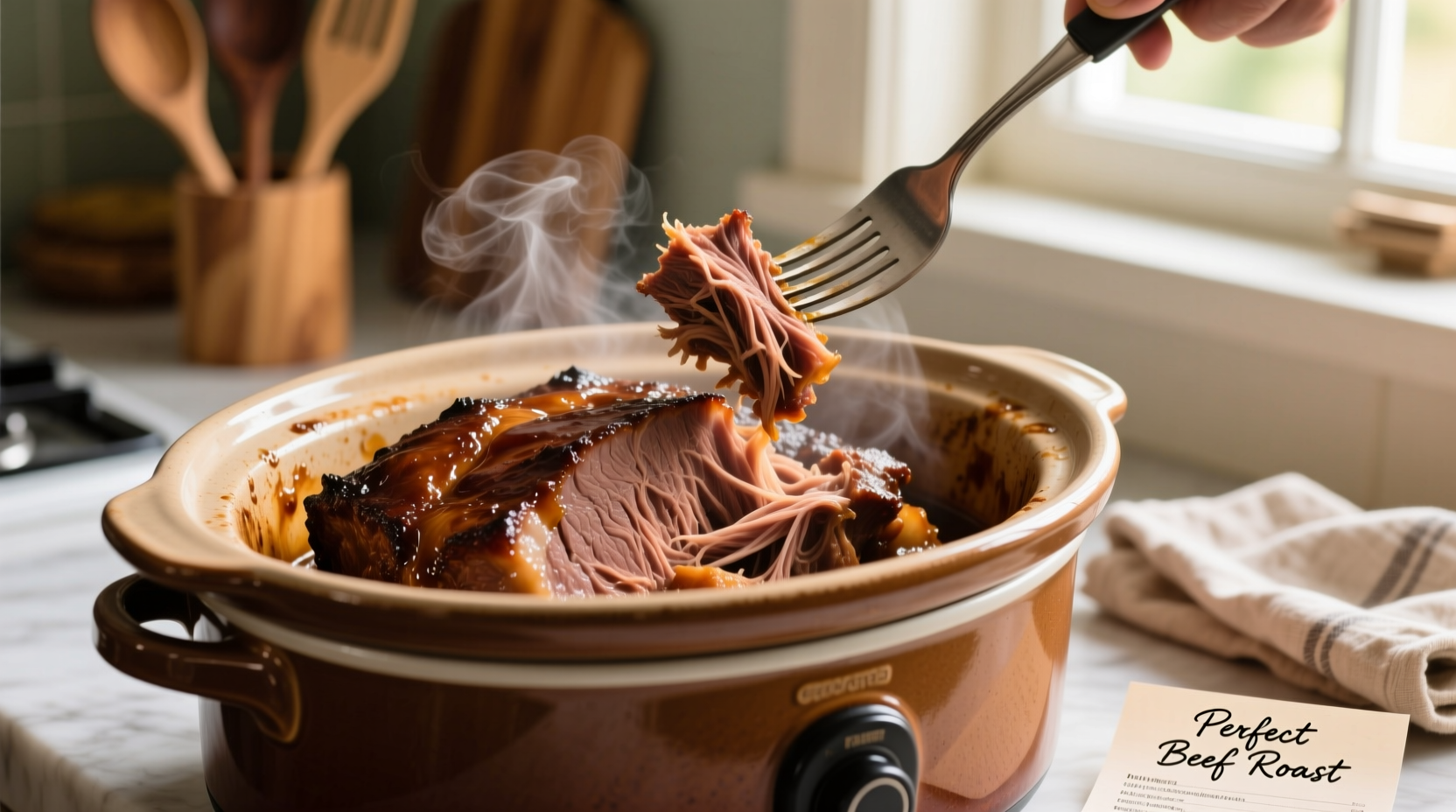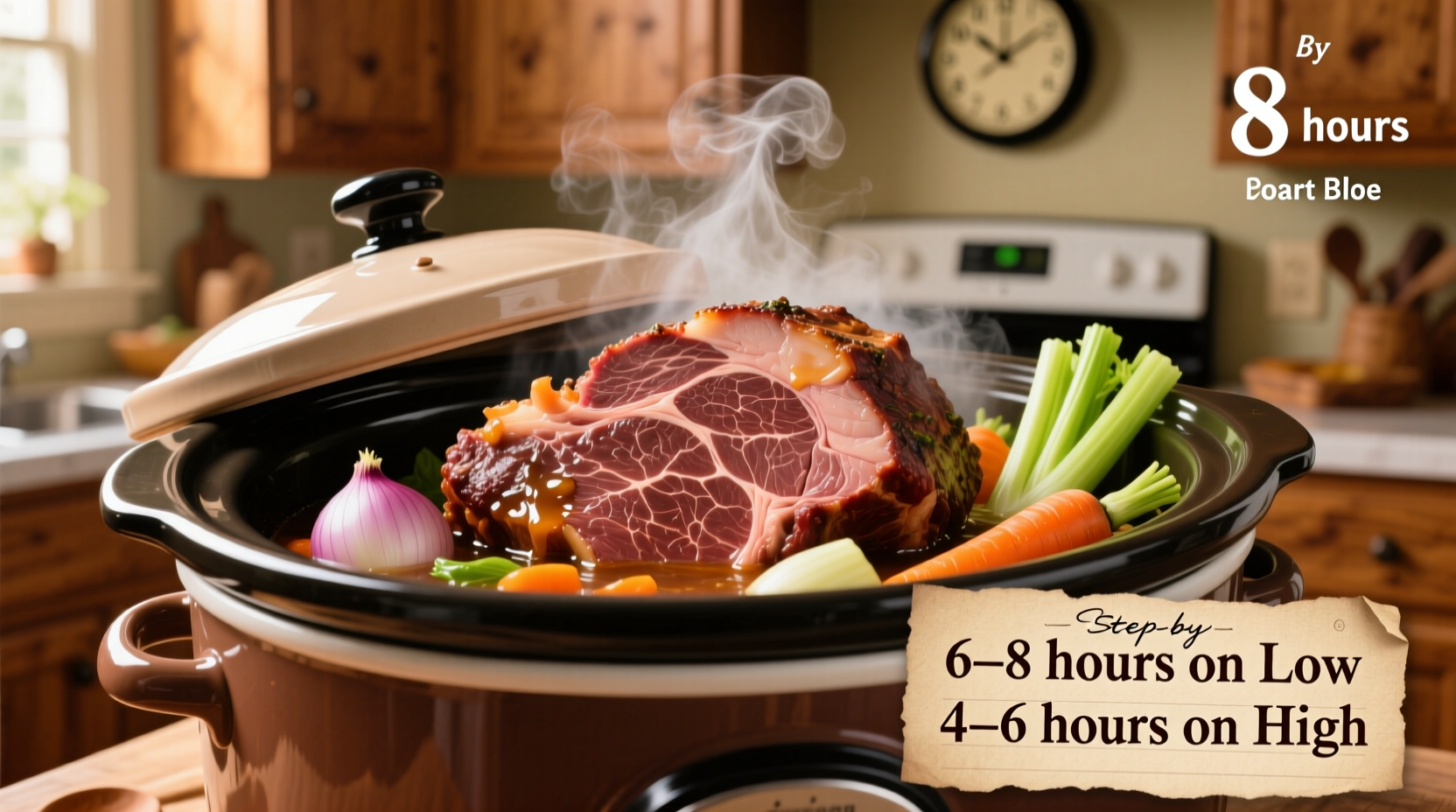For a perfectly tender chuck roast in your slow cooker, cook on LOW for 8-10 hours or on HIGH for 5-6 hours. The roast is done when it reaches an internal temperature of 195-205°F and shreds easily with a fork. This precise timing ensures connective tissues fully break down while maintaining moisture.
There's nothing quite like coming home to the aroma of a perfectly cooked chuck roast that falls apart at the touch of a fork. As someone who's tested countless slow-cooker methods in professional kitchens and home settings, I've discovered the exact timing sweet spot that transforms this tough cut into culinary magic. Let's get you consistently delicious results every time you fire up your slow cooker.
Why Chuck Roast Needs Specific Slow Cooking Times
Chuck roast comes from the shoulder area of the cow, making it rich in connective tissue and marbling. This cut requires proper time at low temperatures to transform tough collagen into gelatin. According to the USDA Food Safety and Inspection Service, connective tissues begin breaking down at 160°F but require several hours to fully transform.
The American Meat Science Association confirms that optimal tenderness for chuck roast occurs between 195-205°F internal temperature, which can only be achieved through extended cooking times. Rushing the process results in tough, chewy meat that hasn't had time for complete collagen conversion.
Preparation: Setting Up for Success
Proper preparation significantly impacts your final cooking time and results:
- Pat dry thoroughly - Moisture on the surface prevents proper browning
- Sear properly - Brown all sides in hot oil (3-4 minutes per side) to develop flavor through the Maillard reaction
- Trim excess fat - Leave about 1/4 inch for flavor but remove large chunks that won't render
- Cut vegetables uniformly - Larger chunks (1.5-2 inches) prevent them from turning to mush
Skipping the sear step might save 10 minutes upfront but sacrifices significant flavor development. The UC Berkeley American Cultures Program notes that proper browning creates over 100 new flavor compounds that enhance the entire dish.
Slow Cooker Timing Guide: Factors That Matter
Your exact cooking time depends on several factors beyond just the slow cooker setting. Here's a comprehensive timing reference:
| Slow Cooker Setting | Weight Range | Minimum Time | Ideal Time | Maximum Time | Internal Temp Range |
|---|---|---|---|---|---|
| LOW (200°F) | 2-3 lbs | 7 hours | 8-9 hours | 10 hours | 195-205°F |
| LOW (200°F) | 3-4 lbs | 8 hours | 9-10 hours | 11 hours | 195-205°F |
| HIGH (300°F) | 2-3 lbs | 4 hours | 5-6 hours | 7 hours | 195-205°F |
| HIGH (300°F) | 3-4 lbs | 5 hours | 6-7 hours | 8 hours | 195-205°F |
Important note: These times assume your slow cooker is at least half full but not more than two-thirds full. Overfilling reduces cooking efficiency, while underfilling can cause faster evaporation and potential drying.
The Critical Temperature Threshold
Time alone doesn't guarantee perfect results. The USDA National Agricultural Library confirms that chuck roast requires reaching 195-205°F internally to achieve maximum tenderness. This temperature range allows complete collagen breakdown without excessive moisture loss.
Using a meat thermometer isn't optional for reliable results. Digital probe thermometers with remote monitoring capabilities work best for slow cooking, allowing you to check temperature without losing heat and moisture from repeated lid openings.

Troubleshooting Common Timing Issues
Even with proper timing, issues can arise. Here's how to address them:
When Your Roast Isn't Tender Enough
If your chuck roast hasn't reached pull-apart tenderness at the expected time:
- Check your slow cooker temperature with a separate thermometer (many run cooler than labeled)
- Ensure you're not opening the lid frequently (each opening adds 20-30 minutes to cooking time)
- Verify the roast wasn't frozen when added (thaw completely first)
- Continue cooking in 30-minute increments until desired tenderness
When Your Roast Is Too Dry
Dryness typically indicates overcooking or insufficient liquid:
- Never cook beyond 10 hours on LOW or 7 hours on HIGH for standard chuck roasts
- Maintain proper liquid ratio (at least 1 cup liquid per pound of meat)
- Keep vegetables underneath the meat to create a natural barrier from direct heat
- Always let the roast rest covered for 15-20 minutes before serving
Enhancing Flavor Throughout the Cooking Process
Timing isn't the only factor in delicious chuck roast. Strategic additions at different stages maximize flavor:
- At the beginning: Add acidic components like tomatoes or wine to help break down fibers
- Middle third of cooking: Add delicate vegetables like carrots and potatoes
- Final hour: Stir in fresh herbs for bright flavor notes
- After cooking: Skim excess fat from the surface before serving
The Culinary Institute of America's research shows that adding vegetables at the right time prevents them from becoming mushy while still absorbing maximum flavor from the cooking liquid.
Serving and Storage Guidelines
Proper handling after cooking preserves your perfectly timed effort:
- Resting time: Allow 15-20 minutes covered before shredding (critical for moisture retention)
- Serving temperature: Maintain between 140-165°F for food safety
- Refrigeration: Store in airtight container for up to 4 days
- Freezing: Portion with cooking liquid for up to 3 months
- Reheating: Gently warm in cooking liquid to maintain moisture
Following these storage guidelines ensures your carefully timed cooking effort doesn't go to waste. The FDA Food Code specifies that cooked beef should be cooled from 135°F to 70°F within 2 hours and to 41°F or below within 6 total hours for safe storage.
Perfecting Your Slow Cooker Chuck Roast Technique
Mastering chuck roast timing in your slow cooker transforms an inexpensive cut into a luxurious meal. Remember that visual and textural cues matter more than the clock alone. When your fork slides in with no resistance and the meat separates effortlessly along the grain, you've hit the sweet spot of time, temperature, and technique.
With these guidelines, you'll consistently produce fall-apart tender chuck roast that impresses family and friends. The slow and steady approach pays off with deep, developed flavors and melt-in-your-mouth texture that only proper timing can deliver.











 浙公网安备
33010002000092号
浙公网安备
33010002000092号 浙B2-20120091-4
浙B2-20120091-4